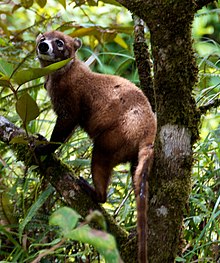White-nosed coati
| White-nosed coati | |
|---|---|

| |
| in Costa Rica | |
Conservation status
| |
| Scientific classification | |
| Kingdom: | Animalia |
| Phylum: | Chordata |
| Class: | Mammalia |
| Order: | Carnivora |
| Family: | Procyonidae |
| Genus: | Nasua |
| Species: | N. narica
|
| Binomial name | |
| Nasua narica (Linnaeus, 1766)
| |
| Subspecies[2] | |
| |

| |
| The native range of the white-nosed coati. Note: Its Colombian range is restricted to the far northwest (see text). | |
| Synonyms | |
|
Viverra narica (Linnaeus, 1766) | |
The white-nosed coati (Nasua narica),[2] also known as the coatimundi (/koʊˌɑːtɪˈmʌndi/),[1][3] is a species of coati and a member of the family Procyonidae (raccoons and their relatives). Local Spanish names for the species include pizote, antoon, and tejón, depending upon the region.[4] It weighs about 4–6 kg (8.8–13.2 lb).[5] However, males are much larger than females: small females can weigh as little as 2.5 kg (5.5 lb), while large males can weigh as much as 12.2 kg (27 lb).[6][7] On average, the nose-to-tail length of the species is about 110 cm (3.6 ft) with about half of that being the tail length.
Distribution and habitat[]

The white-nosed coati is distributed from southeastern Arizona and New Mexico through Mexico and Central America; in Colombia, it is limited to the far northwestern region near the border with Panama.[8][9] It inhabits wooded areas in tropical and subtropical dry broadleaf forests and in tropical and subtropical moist broadleaf forests at elevations from sea level to 3,000 m (9,800 ft).[10]
Coatis from Cozumel Island have been treated as a separate species, the Cozumel Island coati, but the vast majority of recent authorities treat it as a subspecies, N. narica nelsoni, of the white-nosed coati.[2][1][10][11] They are smaller than white-nosed coatis from the adjacent mainland (N. n. yucatanica), but when compared more widely to white-nosed coatis the difference in size is not as clear.[8] The level of other differences also support its status as a subspecies rather than separate species.[8]
White-nosed coatis have also been found in Florida, where they were introduced. It is unknown precisely when introduction occurred; an early specimen in the Florida Museum of Natural History, labeled an "escaped captive", dates to 1928. There are several later documented cases of coatis escaping captivity, and since the 1970s there have been a number of sightings, and several live and dead specimens of various ages have been found. These reports have occurred over a wide area of southern Florida, and there is probable evidence of breeding, indicating that the population is well established.[12]
Behavior and ecology[]
White-nosed coatis are known pollinators of the balsa tree, as observed in a study of a white-nosed coati population in Costa Rica.[13] The coati were observed inserting their noses into the flowers of the tree and ingesting nectar, while the flower showed no subsequent signs of damage. Pollen from the flowers covers the face of the coati following feeding, and later disseminates through the surrounding forest following detachment. Scientists observed a dependent relationship between the balsa tree, which provides a critical resource of hydration and nutrition to the white-nosed coati when environment resources are scarce, and the coati, which increases proliferation of the tree through pollination.[citation needed]
Feeding habits[]
The white-nosed coati is an omnivore and forages mostly on the ground for small vertebrates, fruits, carrion, insects, snakes, and eggs. It can climb trees easily and uses its tail for balancing.[citation needed]
References[]
- ^ a b c Cuarón, A.D.; Helgen, K.; Reid, F.; Pino, J.; González-Maya, J.F. (2016). "Nasua narica". IUCN Red List of Threatened Species. 2016: e.T41683A45216060. doi:10.2305/IUCN.UK.2016-1.RLTS.T41683A45216060.en. Retrieved 19 November 2021.
- ^ a b c Wilson, D.E.; Reeder, D.M., eds. (2005). "Species Nasua narica". Mammal Species of the World: A Taxonomic and Geographic Reference (3rd ed.). Johns Hopkins University Press. ISBN 978-0-8018-8221-0. OCLC 62265494.
- ^ Animal Diversity Web at University of Michigan. "Coatis are also referred to in some texts as coatimundis. The name coati or coatimundi is Tupian Indian in origin."
- ^ "Tejón", which means badger, is mainly used in Mexico.
- ^ David J. Schmidly; William B. Davis (1 August 2004). The mammals of Texas. University of Texas Press. p. 167. ISBN 978-0-292-70241-7.
- ^ North American Mammals: Nasua narica. Mnh.si.edu. Retrieved on 2011-09-15.
- ^ Coati (Nasua narica). Wc.pima.edu. Retrieved on 2011-09-15.
- ^ a b c Decker, D. M. (1991). "Systematics Of The Coatis, Genus Nasua (Mammalia, Procyonidae)" (PDF). Proceedings of the Biological Society of Washington. 104: 370–386.
- ^ Guzman-Lenis, A. R. (2004). "Preliminary Review of the Procyonidae in Colombia" (PDF). Acta Biológica Colombiana. 9 (1): 69–76.
- ^ a b Reid, F. A. (1997). A Field Guide to the Mammals of Central America and Southeast Mexico. pp. 259–260. ISBN 0-19-506400-3. OCLC 34633350.
- ^ Kays, R. (2009). White-nosed Coati (Nasua narica), pp. 527–528 in: Wilson, D. E., and R. A. Mittermeier, eds. (2009). Handbook of the Mammals of the World. Vol. 1, Carnivores. ISBN 978-84-96553-49-1
- ^ Simberloff, D.; Schmitz, D. C.; Brown, T. C. (1997). Strangers in Paradise: Impact and Management of Nonindigenous Species in Florida. Island Press. p. 170. ISBN 1-55963-430-8.
- ^ Mora, J.M. (1999). "White-nosed coati Nasua narica (Carnivora: Procyonidae) as a potential pollinator of Ochroma pyramidale (Bombacaceae)" (PDF). Revista de Biología Tropical. 47 (4): 719–721.
External links[]
| Wikimedia Commons has media related to Nasua narica. |
- IUCN Red List least concern species
- Procyonidae
- Carnivorans of North America
- Carnivorans of Central America
- Carnivorans of South America
- Mammals of the Caribbean
- Mammals of Colombia
- Mammals of Mexico
- Mammals of the United States
- Fauna of the Southwestern United States
- Mammals described in 1766
- Least concern biota of North America
- Least concern biota of South America
- Taxa named by Carl Linnaeus
